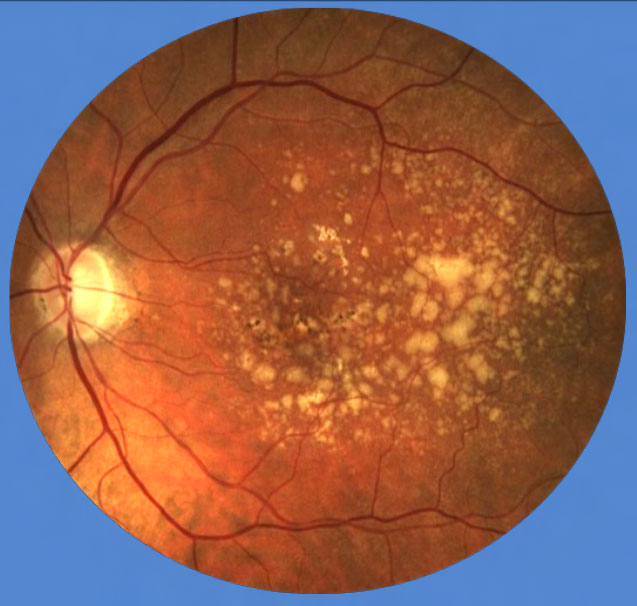 |
|
Of all evaluated methods of detecting nAMD in a fellow eye, OCT proved most effective. Image courtesy of Mohammad Rafieetary, OD. Click image to enlarge. |
Fundus fluorescein angiography (FFA) is commonly used to detect neovascular age-related macular degeneration (nAMD), but when it comes to monitoring the fellow eye for related ocular changes, there isn’t enough evidence of the accuracy of associated diagnostic tests.
Researchers recently sought to determine the best strategy in the detection of nAMD in fellow eyes of those with the condition in their first eye. They evaluated self-reported vision, Amsler grid, clinic-measured visual acuity, fundus assessment and OCT as possible methods.
The team monitored 552 nAMD participants 50 years of age and older for up to three years. Of the total patients, 145 developed active nAMD in the study eye (120 underwent FFA at baseline). Of those who had confirmed nAMD on FFA, five self-reported worse vision, 33 displayed distortion on the Amsler grid, 36 exhibited a 10-letter decrease in acuity from baseline, 64 had nAMD findings on fundus examination and 110 showed nAMD on OCT. Index test sensitivities were: self-reported vision 4.2%, Amsler grid 33.7%, visual acuity 30%, fundus examination 53.8% and OCT 91.7%. All five index test specificities were high at 97%, 81.4%, 66.3%, 97.6% and 87.8%, respectively.
“We found that all analyses pointed clearly to OCT as the most accurate index test and suitable for use on its own,” the authors concluded in their study. “Although self-reported vision and clinical examination showed high specificity, these and the other index tests apart from OCT performed poorly for sensitivity and are therefore unsuitable for monitoring for the onset of nAMD.”
The authors highlighted the poor performance of visual acuity as a major concern for several reasons, especially when it comes to home monitoring for the detection of new-onset nAMD in light of COVID-19, which also includes web-based applications of the Amsler grid and other visual function measurements.
“Our study clearly confirms that reliance on psychophysical technologies that measure visual change or self-reported symptoms will result in both a lower detection rate and a higher false positive rate,” the authors explained in their study. “Considering this risk-benefit ratio, it is important to evaluate home-monitoring devices using visual function to monitor AMD diagnosis or treatment response in pragmatic trials conducted in real world settings before introducing them into clinical practice.
The investigators caution moving away from in-clinic OCT and toward at-home monitoring to limit patient interaction, suggesting that this may actually do more harm than good. “Our study results recommend further research on remote monitoring using OCT rather than visual function measures,” they said. They noted that their findings could warrant a change in current clinical guidelines for nAMD detection.
Sivaprasad S, Banister K, Azuara-Blance A, et al. Diagnostic accuracy of monitoring tests of fellow eyes in patients with unilateral neovascular age related macular degeneration. Ophthalmology. July 21, 2021. [Epub ahead of print]. |

